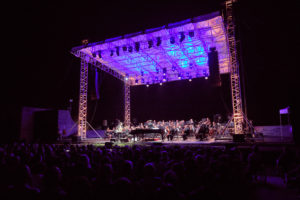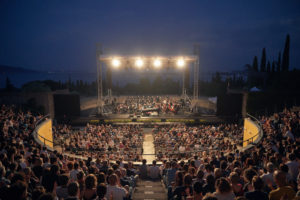
Taketo Gohara, FOH of Vinicio Capossela and Orchestra
This Summer, on the tour of the legendary Italian singer songwriter Vinicio Capossela, Taketo Gohara was the FOH for the Italian artist who was accompanied by the two Italian orchestras; the well-known Filarmonica Arturo Toscanini from the North of Italy and for the concerts in the South the Orchestra Teatro Massimo from Palermo.

REMIC MICROPHONES with built-in Windshield eliminate Wind Noise when performing in ancient Roman Amphitheatres
Most of the concerts of the Summer tour took place in open air venues and ancient Roman theatres in Italy. Prior to the tour, Taketo pointed out that wind noise was a challenge as he had to capture sound in open air performances. To end the uncontrollable challenge of wind noise in microphones in open air productions, REMIC MICROPHONES developed a new microphone model for violin, viola, cello and bass with a built-in windshield. Taketo used the REMIC LB (live) microphone models with windshield for 17 of the string players of the orchestras.

Here we bring an interview with Taketo Gohara about his experience with the new REMICs with built-in windshields:
Q: Most of the concerts took place in open-air theatres, which is very common in Italy. Which are the main challenges in terms of sound production at open-air concerts?
A: “The biggest challenge in open-air venues is to recreate an orchestra sound that is well mixed and reverberated, as if you were in a traditional theatre.”
Q: Were there distinctive challenges in terms of sound production in the different venues?
A: “Absolutely, as some of them were amphitheatres, others were forums. Some stages were solid, while others where hollow underneath. The setting changed from time to time, so did the response in terms of sound quality.”
Q: How do you usually go about the challenge of wind noise on the instruments’ microphones at open-air concerts?
A: “By putting pop filters on each microphone.”
Q: During the tour you made use of REMIC MICROPHONES with built-in windshield. How did you like this solution?
A: “They were striking! Also in very windy venues, like the amphitheatre in Taormina, there was no noise disturbance due to the wind whatsoever.”
Q: How did you use REMICs on the strings of the orchestras?
A: “I have used them for the prime sessions. We had 10 first violins, 8 second violins, 6 violas, 5 celli and 4 double basses. At least half of them in each section had the REMICs on their instruments.”
Q: What was the artists’ general take on the REMICs?
A: “The musicians immediately found themselves at ease with the mics. They are easy to fit and the cotton-lined cable does not damage the instrument. At the end of the tour they asked me where they could buy them.”
Q: What is your general impression of the REMICs?
A: “I was very pleased to use the REMICs. I was very happy with the sound. I enjoyed great sound presence and the sound stayed faithful to the instruments. Matched with a good reverberation, it was like being in a concert hall. Very little noise disturbance.”
Q: How about the visibility? The instruments were barely visible, were they? Even with windscreen.
A: “I like it that there was very little encumbrance.”
Q: Was there any need for additional windscreens?
A: “No, there was no need for that.”
About Taketo Gohara
Taketo Gohara is a sought after and highly respected Japanese/Italian producer, sound engineer and educator born and based in Milan, Italy, but graduated from a school in Japan.
He is a highly esteemed and in demand producer for several singer songwriters with artistic profiles in the rock and folk genres. He does a lot of surround mixing for soundtracks and teach music production in several schools.
Taketo works internationally, mainly in Italy, the US, UK, Japan and Spain. Taketo’s main focus is studio recordings, but he also is hired for live performances like the recent this summer tour with the Italian legendary singer songwriter Vinicio Capossela and orchestra.

